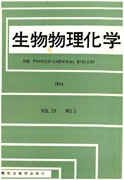All issues

Successor
Volume 19, Issue 5
Displaying 1-4 of 4 articles from this issue
- |<
- <
- 1
- >
- >|
-
II. Amylase-linked immunoglobulinTakashi Kanno, Kayoko Sudo, Shojiro Kano1975Volume 19Issue 5 Pages 361-366
Published: October 25, 1975
Released on J-STAGE: March 31, 2009
JOURNAL FREE ACCESSMany cases of macromolecular amylases were reported. Various modes of complex formation with normal amylase were considered to be categorized as follows: 1. a polymer complex of normal amylases, 2. a complex of normal amylase and plasma proteins other than immunoglobulins (e. g., some glycoproteins), 3. a complex of normal amylase and some other large non-protein molecules (e. g., glycogen or other mucopolysaccharides) and 4. a complex of amylase and immunoglobulins.
In this study, four cases of amylase-linked immunoglobulins were reported and the mode of binding form between amylase and immunoglobulins were discussed.
Three of the cases were tumor-bearing patients of lung, gastric and esophageal cancer, and therapeutically, pancreatic enzyme preparations were not administered in the past three years. The last one was a patient with liver cirrhosis and chronic pancreatitis who have not been administered with pancreatic drugs.
The class of heavy chain of amylase linked immunoglobulin was proved to be γ in three and α in one of the cases by immunoelectrophoresis followed by amylase activity staining. The type of light chain was determined to be exclusively λ irrespective of heavy chain class.
In three of the cases, the immunoglobulin complexes were partially dissociated into normal amylase and immunoglobulin G at pH8.6, and completely dissociated at pH9.0. These phenomena of dissociation might give a clue to explain the heterogeneity of macromolecular amylases which have been discussed previously.
Papain digestion of amylase linked immunoglobulin G was carried out to elucidate the specific antigen-antibody bindings of these macromolecular complexes. The molecular size of the digest was determined to be smaller by thin layer gel-filtration. The precipitin line formed against anti-Fab antiserum was proved to have amylase activity, but that against anti-Fc was not. This fact suggests that the binding site of amylase linked immunoglobulin G was located in Fab portions and that the complexes are specific antigen-antibody complexs.
Thus, it was elucidated that the complex formation of amylases and immunoglobulins in blood plasma is one of the circulating autoantibodies and must be clearly distinguished from the other unknown macromolecular amylase complexes.View full abstractDownload PDF (4775K) -
An Application of Preparative Disc Electrophoresis for Characterization of Canine Serum LipoproteinsMitsuo Wada, Tadashi Minamisono, Akira Akamatsu, Takao Morita, Hideo F ...1975Volume 19Issue 5 Pages 367-371
Published: October 25, 1975
Released on J-STAGE: March 31, 2009
JOURNAL FREE ACCESSA polyacrylamide gel system for human serum lipoprotein electrophoresis was applied successfully to the separation and isolation of canine serum lipoproteins employing a preparative gel slab method combined with slicing technique.
With our gel system in which serum lipoproteins are stained prior to electrophoretic separation, the separation of lipoproteins was visible on polyacrylamide gel and the procedure was simple and accurate. Prestaining of serum lipoproteins did not disturb lipoprotein or lipoprotein lipid analyses. Canine serum lipoproteins were separated always into 4 fractions, i. e., 3 subfractions of α lipoprotein (albumin, α-1 and α-2 lipoproteins) and β lipoprotein.Alpha-1 lipoprotein is the principal fraction of serum lipoproteins of normal dogs. Lipoproteins and lipoprotein lipids were extracted from the gel blocks with sufficient recoveries to conduct further studies. Lipid extracts from each lipoprotein showed unique lipid composition differentiable from the extracts of other lipoproteins. Cross contamination of lipoprotein extracts seemed negligible if any as far as examined by lipoprotein lipid analysis or immunoelectrophoresis of the isolated lipoproteins. However, immunoelectrophoresis of whole sera and lipoprotein extracts against rabbit anti-canine immune sera showed partially discordant results suggesting complicated distribution of antigenic components.
It was concluded that with the method explored in this work further studies on canine serum lipoproteins seem to yield valuable results.View full abstractDownload PDF (3931K) -
Mitsuo Wada, Makoto Komoda, Jun'ichi Mise1975Volume 19Issue 5 Pages 373-378
Published: October 25, 1975
Released on J-STAGE: March 31, 2009
JOURNAL FREE ACCESSSerum lipoprotein polyacryamide gel disc electrophoresis aided by paper electrophoresis was proved to be effective to detect and identify convincingly modest to moderate hyperlipoproteinemias which are frequently encountered in atherosclerotic cardiovascular clinic. Hyperbeta lipoproteinemia with moderate increase of pre-β lipoprotein (Bp pattern, type II-B of WHO definition) showed closest association with ischemic heart disease. Premature development of ischemic heart disease in the patients with this lipoprotein pattern was evident. Hyperbeta lipoproteinemia (B pattern, type II-A of WHO definition) showed also close association with high incidence and premature development of ischemic heart disease. Hyperprebeta lipoproteinemia (Pb pattern, type IV of WHO definition) occurred most frequently among atherosclerotic cardiovascular patients, though incidence of ischemic heart disease was lower than those with Bp or B patterns. The mixed hyperlipoproteinemia (PB pattern, the sixth phenotype) which is identifiable most adequately with PAG disc method showed the incidence of ischemic heart disease comparable to those in Pb pattern and the occurrence comparable to those in B pattern. The sixth phenotype should be the seventh phenotype because phenotype II-B (Bp pattern) is clearly differentiable from the mixed hyperlipoproteinemia (PB pattern).View full abstractDownload PDF (2411K) -
1975Volume 19Issue 5 Pages 379-459
Published: October 25, 1975
Released on J-STAGE: March 31, 2009
JOURNAL FREE ACCESSDownload PDF (54049K)
- |<
- <
- 1
- >
- >|